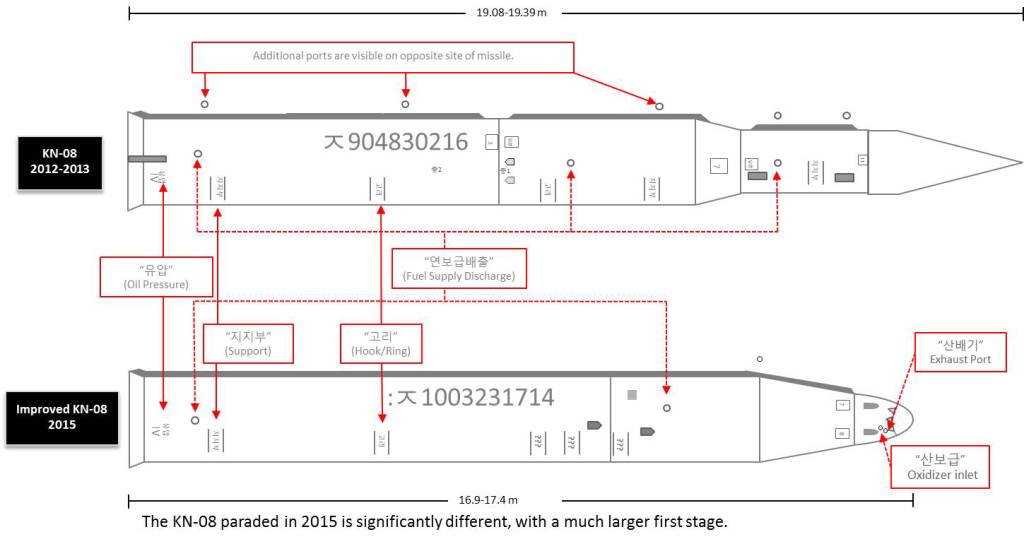What’s “Under the Hood”
Continued from:
“A New ICBM for North Korea?”
We can try to put all of this together and figure out just what sort of missile the KN-08 Mod 2 is, but the lack of detail will require a certain amount of guesswork as to what has changed.
One thing that probably hasn’t changed is the first-stage engines. The base of the vehicle, including the flared skirt and the propellant discharge port 1.6 meters up the side, looks just like it did in 2013 (minus the rivets). So we can reasonably assume that, except for stretching the tanks, the first-stage configuration is the same as it was before, with four modified Scud engines burning relatively low-energy kerosene and nitric acid propellants. The first stage, provided it has enough thrust to fly at all, is generally the least important to a missile’s overall performance, so it would make sense to keep as much already-developed hardware there as possible.
If this were a three-stage missile, we would expect that the second stage would remain unchanged as well. This fits the dimensions of the mock-up quite well. In this hypothesis, the only things that have changed are the third stage and the reentry vehicle. The third stage would use the same propulsion and guidance hardware as before, but the propellant tanks would have to be squeezed into the conical volume at the front of the missile.
The problem with this hypothesis is that, after a substantial redesign of the third stage, the missile’s performance would remain almost unchanged. And why do such a redesign if it doesn’t get you anything? Even the new blunt-body RV would have fit perfectly well under a fairing shaped to the old design.
It is far more likely that the reason we can’t see a third stage is because there isn’t one. Instead, the propellant tanks for the first and second stages have been stretched. This would normally rob the missile of some of its already-marginal performance, but as noted, we have reason to believe that the North Koreans and their friends have managed to improve the structural design with a significant reduction in dry mass and residual propellants. The second stage will necessarily have undergone a more substantial redesign, as it has to incorporate the guidance system previously located in the third stage. Again, we will assume an improved structural design. There is no need for a post-boost propulsion system, as the missile can accommodate only a single warhead and the small vernier engines of the second stage can handle post-boost velocity trim. And we assume a blunt, forward-facing RV, as anything else would add complexity but no real gain.
A few other possibilities have been considered but are deemed highly unlikely. The North Koreans could improve the performance of the missile somewhat by using common-bulkhead propellant tanks, or submerging the upper-stage engines in the propellant of the stage below. But these are complex and somewhat dangerous ways of squeezing a bit more propellant into a missile, when the same result could be accomplished by simply making the missile a bit longer. For SLBMs that can be crucial, but the KN-08 lives on an overgrown truck and the Mod 2 could easily grow by another two meters.
As already noted, we do not see any evidence to support the hypothesis that this is actually an ex-Soviet SLBM, whether the R-29 or otherwise. Nor is there any evidence to suggest that this is a solid-fuel missile, and the presence of fuel discharge ports argues strongly against that hypothesis.
Diagrams of the missile’s outer mold line, and the postulated interior configurations, are shown in figures 4 and 5, below.


Return to last section: No More Rivets
Next section: What’s the Bottom Line?
